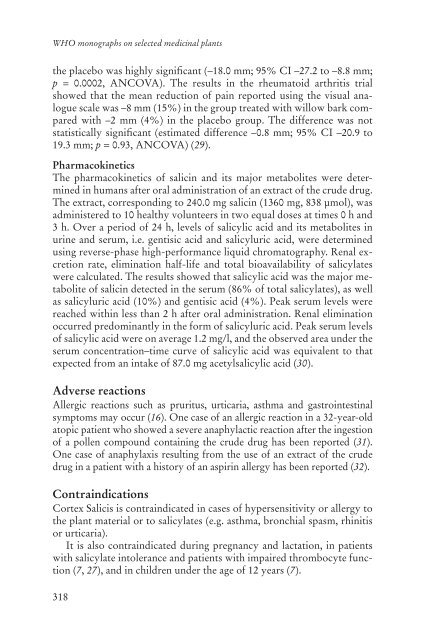WHO monographs on selected medicinal plants - travolekar.ru
WHO monographs on selected medicinal plants - travolekar.ru
WHO monographs on selected medicinal plants - travolekar.ru
You also want an ePaper? Increase the reach of your titles
YUMPU automatically turns print PDFs into web optimized ePapers that Google loves.
<str<strong>on</strong>g>WHO</str<strong>on</strong>g> <str<strong>on</strong>g>m<strong>on</strong>ographs</str<strong>on</strong>g> <strong>on</strong> <strong>selected</strong> <strong>medicinal</strong> <strong>plants</strong><br />
the placebo was highly significant (–18.0 mm; 95% CI –27.2 to –8.8 mm;<br />
p = 0.0002, ANCOVA). The results in the rheumatoid arthritis trial<br />
showed that the mean reducti<strong>on</strong> of pain reported using the visual analogue<br />
scale was –8 mm (15%) in the group treated with willow bark compared<br />
with –2 mm (4%) in the placebo group. The difference was not<br />
statistically significant (estimated difference –0.8 mm; 95% CI –20.9 to<br />
19.3 mm; p = 0.93, ANCOVA) (29).<br />
Pharmacokinetics<br />
The pharmacokinetics of salicin and its major metabolites were determined<br />
in humans after oral administrati<strong>on</strong> of an extract of the c<strong>ru</strong>de d<strong>ru</strong>g.<br />
The extract, corresp<strong>on</strong>ding to 240.0 mg salicin (1360 mg, 838 μmol), was<br />
administered to 10 healthy volunteers in two equal doses at times 0 h and<br />
3 h. Over a period of 24 h, levels of salicylic acid and its metabolites in<br />
urine and se<strong>ru</strong>m, i.e. gentisic acid and salicyluric acid, were determined<br />
using reverse-phase high-performance liquid chromatography. Renal excreti<strong>on</strong><br />
rate, eliminati<strong>on</strong> half-life and total bioavailability of salicylates<br />
were calculated. The results showed that salicylic acid was the major metabolite<br />
of salicin detected in the se<strong>ru</strong>m (86% of total salicylates), as well<br />
as salicyluric acid (10%) and gentisic acid (4%). Peak se<strong>ru</strong>m levels were<br />
reached within less than 2 h after oral administrati<strong>on</strong>. Renal eliminati<strong>on</strong><br />
occurred predominantly in the form of salicyluric acid. Peak se<strong>ru</strong>m levels<br />
of salicylic acid were <strong>on</strong> average 1.2 mg/l, and the observed area under the<br />
se<strong>ru</strong>m c<strong>on</strong>centrati<strong>on</strong>–time curve of salicylic acid was equivalent to that<br />
expected from an intake of 87.0 mg acetylsalicylic acid (30).<br />
Adverse reacti<strong>on</strong>s<br />
Allergic reacti<strong>on</strong>s such as p<strong>ru</strong>ritus, urticaria, asthma and gastrointestinal<br />
symptoms may occur (16). One case of an allergic reacti<strong>on</strong> in a 32-year-old<br />
atopic patient who showed a severe anaphylactic reacti<strong>on</strong> after the ingesti<strong>on</strong><br />
of a pollen compound c<strong>on</strong>taining the c<strong>ru</strong>de d<strong>ru</strong>g has been reported (31).<br />
One case of anaphylaxis resulting from the use of an extract of the c<strong>ru</strong>de<br />
d<strong>ru</strong>g in a patient with a history of an aspirin allergy has been reported (32).<br />
C<strong>on</strong>traindicati<strong>on</strong>s<br />
Cortex Salicis is c<strong>on</strong>traindicated in cases of hypersensitivity or allergy to<br />
the plant material or to salicylates (e.g. asthma, br<strong>on</strong>chial spasm, rhinitis<br />
or urticaria).<br />
It is also c<strong>on</strong>traindicated during pregnancy and lactati<strong>on</strong>, in patients<br />
with salicylate intolerance and patients with impaired thrombocyte functi<strong>on</strong><br />
(7, 27), and in children under the age of 12 years (7).<br />
318

















